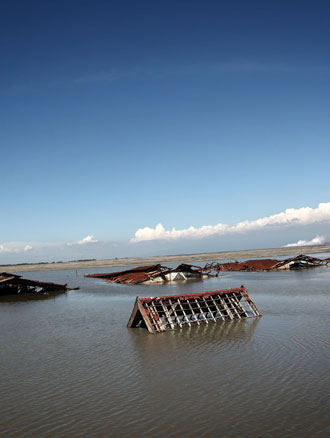June
Earthquake not to blame for Indonesian mud volcano

New research hopes to close the debate on whether a major mud volcano disaster in Indonesia was triggered by an earthquake or had man-made origins.
A mud volcano suddenly opened up in the city of Sidoarjo in East Java, Indonesia, in May 2006. Nine years later the eruption continues – having buried more than 6.5km2 of the city in up to 40m of mud and displacing almost 40,000 people. Costs of the disaster are estimated at over US$2.7 billion.
This latest research, published today in the journal Nature Geoscience, directly addresses the ongoing controversy over the cause of the disaster.
Involving experts from the University of Adelaide, Australia, Newcastle University, UK, and the universities of Portland and California in the US, the team say this new paper “essentially disproves all existing earthquake-triggering models”.
Professor Richard Davies, from Newcastle University, said:
“There are many lines of evidence that have pointed to this being caused by drilling ever since we published our first research paper on it back in 2007. It's nice to finally put the cause to bed, for the sake of the many people who have been affected.”
Dr Mark Tingay, Adjunct Associate Professor with the University of Adelaide's Australian School of Petroleum, added:
"There has been intense debate over the cause of the mud volcano ever since it erupted.
"Some researchers argue that the volcano was man-made and resulted from a drilling accident (a blowout) in a nearby gas well. Others have argued that it was a natural event that was remotely triggered by a large earthquake that occurred 250km away and two days previously. There has been no scientific consensus about this, and it's a very hot topic politically in Indonesia.
"Our new paper essentially disproves all existing earthquake-triggering models."
The study is the first to use actual physical data collected in the days before and after the earthquake, rather than models and comparisons.
The earthquake-trigger theory proposes that seismic shaking induced liquefaction of a clay layer at the disaster location. Clay liquefaction is always associated with extensive gas release, and it is this large gas release that has been argued to have helped the mud flow upwards and erupt on the surface.
However, when the team examined the precise and continuous subsurface gas measurements from the adjacent well they were able to show that there was no gas release following the earthquake.
Using gas signatures from different rocks and the mud eruption itself to 'fingerprint' the initial source of erupting fluids the team were able to demonstrate that erupting fluids were initially sourced from a deep formation, which is only predicted to occur in the drilling-trigger hypothesis.
Taken together, the data strongly supports a man-made trigger.
Dr Tingay explains: “The rocks showed no response to the earthquake, indicating that the earthquake could not have been responsible for the mud flow disaster. Furthermore, the measurements highlight that the onset of underground activity preceding the mud eruption only started when the drilling ‘kick’ occurred, strongly suggesting that the disaster was initiated by a drilling accident.
“We hope this closes the debate on whether an earthquake caused this unique disaster.”
-Ends-
published on: 29 June 2015
